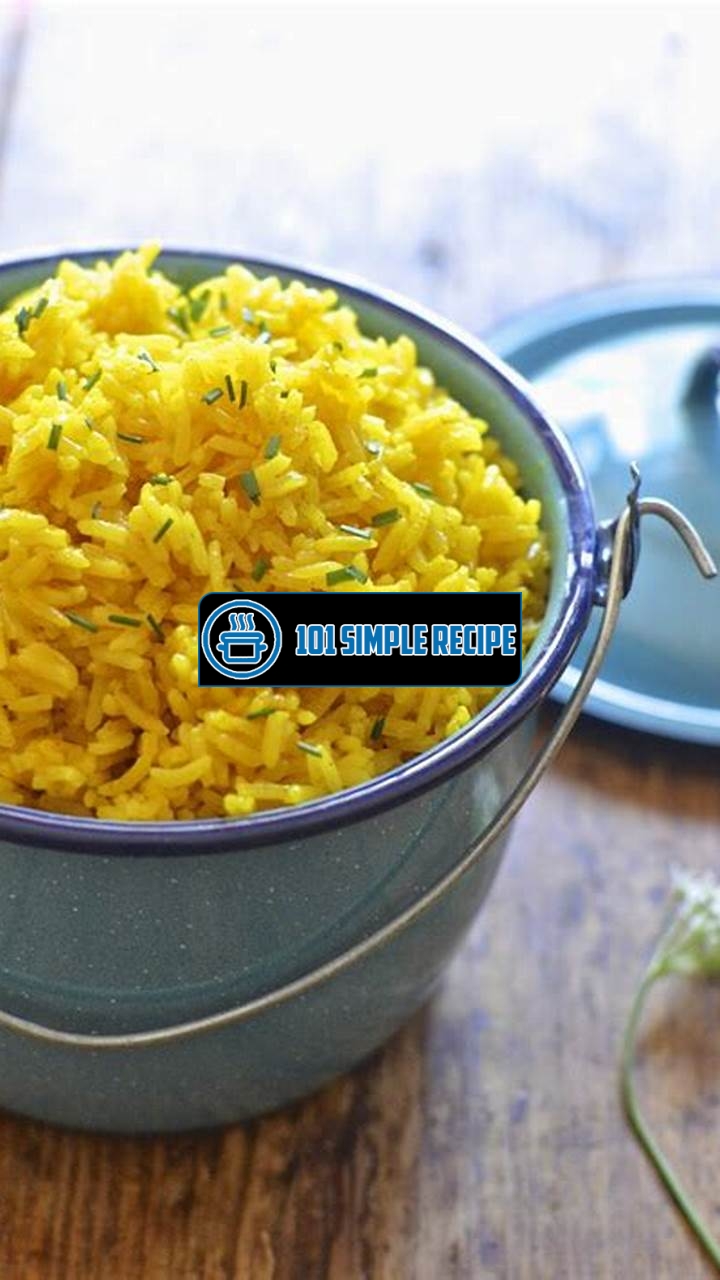Are you tired of eating plain white rice with your meals? If so, it’s time to master the art of homemade yellow rice! This vibrant and flavorful dish adds a pop of color and taste to your table, elevating any meal to a whole new level. Whether you are a novice in the kitchen or a seasoned chef, making yellow rice at home is a breeze. In this article, we will guide you through the step-by-step process of creating this delightful dish, revealing the secret ingredients and techniques that will make your yellow rice stand out. So grab your apron and let’s get cooking!

Understanding Yellow Rice
Yellow rice is a delicious and popular dish that is enjoyed in many cultures around the world. It is known for its vibrant yellow color and fragrant flavor. In this article, we will explore the origins and characteristics of yellow rice, as well as its cultural significance.
The Origins of Yellow Rice
The exact origins of yellow rice are uncertain, as it is a dish that has evolved over time and is embraced by various cultures. However, it is believed to have originated in the Middle East and spread to other regions through trade and exploration.
One theory suggests that yellow rice was first created in ancient Persia, now present-day Iran. It was a staple in Persian cuisine and was often served during special occasions and festivals. Over time, the recipe for yellow rice made its way to other parts of the world, including India, Spain, and Latin America.
The Flavor Profile of Yellow Rice
Yellow rice is known for its aromatic and savory taste. The dish gets its distinct flavor from the combination of spices and ingredients used during the cooking process. Common spices used in yellow rice include turmeric, saffron, cumin, and paprika.
The use of these spices not only gives yellow rice its vibrant yellow color but also enhances its flavor. Turmeric, in particular, adds a subtle earthiness and a hint of bitterness, while saffron imparts a delicate floral aroma. Cumin and paprika contribute a warm and smoky taste that complements the overall dish.
The Cultural Significance of Yellow Rice
Yellow rice holds great cultural significance in many countries and is often associated with celebrations and special occasions. In Indian cuisine, yellow rice, also known as “pulao” or “biryani,” is a staple dish served during festive gatherings and weddings.
In Latin American countries, such as Cuba and Puerto Rico, yellow rice is a traditional accompaniment to various dishes, including black beans, roasted pork, and plantains. It is a symbol of cultural identity and can be found in family recipes passed down through generations.
Yellow rice is also embraced in Spain, where it is known as “arroz amarillo.” It is a popular choice for paella, a traditional Spanish rice dish, and is often paired with seafood or meat.
Overall, yellow rice is more than just a delicious dish. It has a rich history and holds cultural significance in various parts of the world. By understanding its origins, flavor profile, and cultural importance, you can truly appreciate the art of homemade yellow rice.
For those interested in weight loss recipes, here’s a recipe that focuses on healthy ingredients without sacrificing taste.
Choosing the Right Rice
When it comes to making homemade yellow rice, choosing the right type of rice is crucial. The characteristics of the rice you use can greatly impact the final texture and flavor of your dish. In this section, we will explore the different types of rice suitable for making yellow rice and provide tips on how to select the best one for your culinary masterpiece.
Long-Grain Rice Varieties
Long-grain rice is known for its slender and elongated grains. It is the most commonly used type of rice for cooking yellow rice. The long grains remain separate and fluffy when cooked, making it perfect for dishes that require distinct grains. Basmati rice, with its aromatic fragrance, is a popular choice for yellow rice. Its nutty flavor and delicate texture add a delightful dimension to the dish. Remember to rinse the basmati rice before cooking to remove any excess starch.
If you prefer a less aromatic option, you can go for Carolina rice. This variety is widely available and provides a subtle yet pleasing taste. When cooked, the grains of Carolina rice become tender and absorb the flavors of the spices, resulting in a delectable and flavorful yellow rice.
Medium-Grain Rice Varieties
Medium-grain rice has a slightly shorter and plumper grain than long-grain rice. This type of rice is stickier and creamier when cooked, making it ideal for dishes that require a more cohesive texture. However, it is important to note that if you choose medium-grain rice for your yellow rice, the end result may be slightly less fluffy compared to using long-grain rice.
One well-known medium-grain rice variety is Arborio rice. It is commonly used in Italian dishes, particularly risotto. Arborio rice has a high starch content, which lends a creamy texture to the dish. When making yellow rice with Arborio rice, the result will be a beautifully creamy and flavorful rice, perfect for serving as a side dish or as the main course.
Short-Grain Rice Varieties
Short-grain rice is the starchiest type of rice, which makes it incredibly sticky when cooked. This stickiness is due to the higher amylopectin content in short-grain rice. While short-grain rice is not commonly used for making yellow rice, it can still be an interesting and delicious option to explore.
A popular short-grain rice variety is sushi rice. As the name suggests, it is primarily used in sushi recipes. Sushi rice has a sticky and chewy texture that holds well together when seasoned with vinegar and sugar. If you decide to use sushi rice for your yellow rice, expect a stickier and more compact texture, adding a unique twist to your dish.
Remember to consider the texture and flavor you desire for your yellow rice when choosing the right rice variety. Whether it’s the fluffy and aromatic basmati rice, the creamy Arborio rice, or the sticky sushi rice, each option brings its own charm to the dish. Experiment with different rice varieties to find your favorite and master the art of homemade yellow rice!
If you’re in need of a refreshing beverage, try making this punch bowl recipe that’s perfect for parties or gatherings.
Enhancing the Flavor
When it comes to creating the perfect homemade yellow rice, enhancing the flavor is key. By using a combination of various ingredients and spices, you can elevate the taste of your yellow rice to a whole new level. Let’s take a look at some of the options available to you.
Key Ingredients for Yellow Rice
While rice is the main component of yellow rice, there are a few key ingredients that can add an extra layer of flavor. One important ingredient is saffron, which not only gives the rice its vibrant yellow color but also imparts a distinct taste. You can also add a dash of turmeric powder to further enhance the color. Additionally, using high-quality chicken or vegetable broth instead of water can infuse the rice with a rich and savory flavor.
Spices and Herbs for Flavor
Spices and herbs play a crucial role in adding depth to the flavor of yellow rice. Some commonly used spices include cumin, paprika, and garlic powder. These spices add a hint of warmth and smokiness to the dish. You can also incorporate dried herbs like oregano and thyme to introduce a subtle earthy flavor. Don’t forget to season with salt and pepper to taste, as these simple additions can elevate the overall taste of the rice.
Adding Vegetables and Proteins
To make your yellow rice more nutritious and flavorful, consider adding vegetables and proteins to the dish. Chopped onions and bell peppers can add a pleasant crunch and sweetness to the rice. Peas and carrots are also popular choices, as they bring a pop of color and a subtle sweetness. If you prefer a heartier option, you can mix in cooked chicken, shrimp, or even tofu for a protein-packed meal.
By combining these ingredients and spices, you can create a homemade yellow rice that is bursting with flavor. Don’t be afraid to experiment and adjust the quantities according to your personal preferences. Whether you’re serving it as a side dish or as a main course, mastering the art of homemade yellow rice will surely impress your family and friends.
If you’re looking for more homemade recipe ideas, check out this White Castle recipe that will show you how to make their famous sliders at home.
The Cooking Process
When it comes to mastering the art of homemade yellow rice, there are a few key cooking techniques that you need to keep in mind. By following a step-by-step guide, you’ll be able to achieve the perfect texture and flavor every time.
Preparation and Washing of Rice
The first step in cooking yellow rice is to properly prepare and wash the rice. This ensures that any impurities and excess starch are removed, resulting in a cleaner and fluffier end product. Start by measuring out the desired amount of rice, typically 1 cup per serving. Rinse the rice thoroughly under cold water until the water runs clear. This removes any dust or debris that may have accumulated.
Tip: It’s important to rinse the rice until the water is clear to ensure the best texture and flavor.
Sautéing and Seasoning the Rice
The next step in the cooking process is to sauté the rice to enhance its flavor. Heat a tablespoon of oil or butter in a large saucepan over medium-high heat. Add the rinsed rice and sauté until it becomes lightly golden and fragrant. This helps to bring out the nutty flavors of the rice. Once the rice is sautéed, it’s time to add the seasoning. This can vary depending on personal preference, but common spices include turmeric, cumin, garlic powder, and onion powder. The seasonings can be adjusted to taste, ensuring a delicious and aromatic dish.
Pro tip: Sautéing the rice before cooking adds an extra layer of flavor and enhances the overall taste of the dish.
Simmering and Steaming Techniques
Now that the rice is sautéed and seasoned, it’s time to move on to the simmering and steaming techniques. Add water or broth to the saucepan, using a ratio of 2 cups liquid to 1 cup of rice. Bring the mixture to a boil, then reduce the heat to low and cover the pan tightly with a lid. Allow the rice to simmer for about 15-20 minutes, or until the liquid has been absorbed and the rice is tender. Avoid stirring the rice during this process, as it can result in a stickier texture.
Insider tip: For an extra burst of flavor, consider using broth instead of water to simmer the rice. This adds depth and richness to the dish.
Once the rice has simmered, remove it from the heat and let it steam for an additional 5 minutes. This helps to fluff up the grains and allows for a lighter and more airy texture. After the steaming process, you can give the rice a gentle fluff with a fork to separate the grains.
And there you have it – a comprehensive guide to mastering the art of homemade yellow rice. By following these steps and techniques, you’ll be able to create a flavorful and vibrant dish that will impress family and friends alike.
Serving and Pairing Suggestions
When it comes to serving yellow rice, the options are endless. Whether you’re looking for a traditional pairing or something a little more creative, here are some ideas to inspire you:
Garnishing and Presentation Ideas
Garnishing and presentation play a big role in making your homemade yellow rice stand out. Here are some ideas to make your dish visually appealing:
- Sprinkle some fresh chopped cilantro over the rice for a pop of color and a burst of freshness.
- Arrange some thinly sliced lemons or limes on top of the rice for a citrusy touch.
- Add a pinch of saffron threads on the top to give your dish an elegant and exotic look. ✨
By using these garnishing tips, you can take your homemade yellow rice from basic to show-stopping.
Complementary Side Dishes
To make your meal complete, it’s important to pair your yellow rice with complementary side dishes that enhance its flavors. Here are some delicious options:
- Grilled chicken or juicy steak: The savory flavors of grilled meats complement the mild and fragrant taste of yellow rice.
- Black beans: Serve a side of black beans for a classic Latin American combination. The creamy texture and earthy flavor of the beans pairs beautifully with yellow rice.
- Roasted vegetables: Add some roasted veggies such as bell peppers, zucchini, and carrots to your plate for a healthy and colorful side dish.
These side dishes not only add variety to your meal but also provide a well-rounded dining experience.
Fusion and Creative Pairings
If you’re feeling adventurous and want to explore unique flavor combinations, consider these fusion and creative pairings for your yellow rice:
- Spicy shrimp stir-fry: Sauté some shrimp with garlic, chili flakes, and bell peppers, and serve it over yellow rice for a delightful blend of flavors and textures. ️
- Mango salsa: Prepare a tangy mango salsa with diced mangoes, red onions, jalapenos, and lime juice. Serve it alongside your yellow rice for a tropical twist.
- Coconut curry: Prepare a creamy coconut curry with your favorite vegetables and spices, and serve it over yellow rice for a fragrant and satisfying meal.
These fusion dishes bring together different cuisines and ingredients to create a memorable dining experience.
Note: Feel free to experiment with different ingredients and flavors to find your perfect pairing. The versatility of yellow rice makes it a great base for various combinations.
So, go ahead and master the art of homemade yellow rice, and elevate your meals with these serving and pairing suggestions. Bon appétit!
Frequently Asked Questions
Thank you for taking the time to read our article on how to make homemade yellow rice! We hope you found it informative and helpful. If you have any further questions, please refer to the FAQ section below:
| No. | Questions | Answers |
|---|---|---|
| 1. | Can I use brown rice instead of white rice? | Yes, you can use brown rice instead of white rice. However, please note that the cooking time and liquid requirements may vary. |
| 2. | What can I substitute for saffron? | If you don’t have saffron, you can use turmeric as a substitute. However, keep in mind that it will alter the flavor and color of the rice. |
| 3. | How long can I store yellow rice? | You can store yellow rice in an airtight container in the refrigerator for up to 3 days. Make sure to reheat it thoroughly before serving. |
| 4. | Can I add vegetables to the yellow rice? | Absolutely! You can add diced carrots, peas, or bell peppers to the rice to make it more nutritious and flavorful. |
| 5. | Is yellow rice gluten-free? | Yes, yellow rice is gluten-free as long as you use gluten-free ingredients and spices. |
| 6. | Can I freeze yellow rice? | Yes, you can freeze yellow rice. Allow it to cool completely, then transfer it to airtight containers or freezer bags. It can be stored in the freezer for up to 3 months. |
Thank You for Reading!
We hope you enjoyed learning how to make homemade yellow rice. Don’t forget to bookmark our website for more delicious recipes and cooking tips. Visit us again soon for new and exciting culinary adventures! Happy cooking! ☺️
Jump to Recipe
Homemade Yellow Rice

Learn how to make flavorful and aromatic yellow rice at home with this easy recipe. Perfect as a side dish or main course!
- 2 cups long-grain white rice
- 1 tablespoon olive oil
- 1 small onion (diced)
- 2 cloves garlic (minced)
- 1 teaspoon ground turmeric
- 1/2 teaspoon ground cumin
- 1/2 teaspoon paprika
- 1/4 teaspoon saffron threads
- 4 cups chicken or vegetable broth
- Salt (to taste)
- Fresh cilantro (for garnish)
- Rinse the rice under cold water until the water runs clear. Drain well.
- In a large saucepan, heat the olive oil over medium heat. Add the diced onion and minced garlic, and sauté until softened.
- Add the ground turmeric, ground cumin, paprika, and saffron threads to the saucepan. Stir well to coat the onion and garlic with the spices.
- Add the rinsed rice to the saucepan and stir to combine with the spices.
- Pour in the chicken or vegetable broth and season with salt to taste. Bring to a boil, then reduce heat to low, cover, and simmer for 15-20 minutes, or until the rice is cooked and the liquid is absorbed.
- Remove the saucepan from heat and let it sit, covered, for 5 minutes. Fluff the rice with a fork before serving.
- Garnish with fresh cilantro and serve hot. Enjoy!






